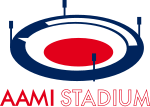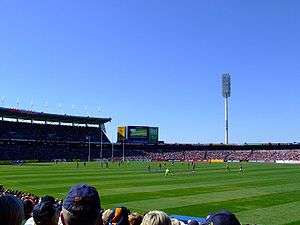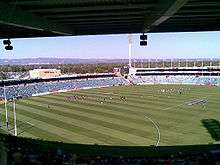Football Park
 | |
 | |
| Location |
Turner Drive, West Lakes, Adelaide, South Australia |
|---|---|
| Coordinates | 34°52′48″S 138°29′44″E / 34.88000°S 138.49556°ECoordinates: 34°52′48″S 138°29′44″E / 34.88000°S 138.49556°E |
| Owner | SANFL |
| Operator | SANFL |
| Capacity | 51,515 |
| Record attendance | 66,897 (Sturt v Port Adelaide, 1976 SANFL Grand Final) |
| Field size | Football: 165m x 135m |
| Surface | Grass |
| Construction | |
| Broke ground | 1971 |
| Opened | 1974 |
| Construction cost | A$6.6m |
| Architect | Various |
| Tenants | |
|
Adelaide Football Club (AFL) (1991–2013) Port Adelaide Football Club (AFL) (1997–2013) Woodville-West Torrens Eagles (SANFL) (1991–1992) Glenelg Tigers (SANFL) (1991) | |
Football Park, also known commercially as AAMI Stadium, is an Australian rules football stadium located in West Lakes, a western suburb of Adelaide, the state capital of South Australia, Australia. It was built in 1973 by the South Australian National Football League and opened in 1974. Until the end of the 2013 AFL season, it served as the home ground of both the Adelaide Crows and Port Adelaide Power.
With a seated capacity of 51,240 Football Park is the fifth largest Australian rules football stadium in Australia in terms of crowd capacity, behind the recently redeveloped Adelaide Oval (53,500), Docklands Stadium in Melbourne (56,347), Stadium Australia in Sydney (83,500) and the Melbourne Cricket Ground (100,024). Adelaide Oval now hosts the Adelaide Crows and the Port Adelaide Power Australian Football League teams from 2014 onwards, and is the fourth largest football stadium in Australia.
History
Ground was broken for Football Park in 1971, giving the SANFL its own venue after years of playing out of the Adelaide Oval, which was controlled by the South Australian Cricket Association (SACA). Due to ongoing conflicts with the SACA, the SANFL had wanted to leave Adelaide Oval and into their own home stadium for a number of years, finally settling on the undeveloped swampland at West Lakes in 1970 (the same year as the similarly designed, but larger VFL Park opened in Melbourne).
The stadium hosted its first football game on 4 May 1974,[1] an SANFL match between Central District and North Adelaide. The first goal was kicked by North's Barry Hearl, but The Bulldogs won the game defeating The Roosters 21.13 (139) to 16.13 (109).
Intended to have a capacity of around 80,000, Football Park was originally standing room only in the outer (along with the usual crush barriers) with bench seating in the main grandstand and ended up with a capacity of approximately 62,000. Bench seating was gradually added to the stadium's bowl section, and the concourse roof was finished in 1982, by which time the grounds capacity had settled to around 55,000. The new roof gave the outer of the ground a limited number of under cover seats, as well as opening up more space for advertising boards. Television screens showing the games in progress at the ground are also in place under the concourse roof, as well as in the members area.
After long-term negotiations with the State Government and the local council, as well as local residents, the SANFL started building the ground's four light towers in late 1983. These were finished by early 1984, with all night games in Adelaide moving from the suburban grounds (Norwood Oval and Thebarton Oval) to league headquarters for the next 16 years. Following the Adelaide Crows joining the AFL in 1991, and being joined by Port Adelaide in 1997, new corporate "superboxes" were built on top of the southern concourse, stretching from the scoreboard around to the members grandstand. The following year (1998) the stadium got its first video superscreen, although the old scoreboard located above the tunnel in the south-east corner remained in place as the main scoreboard.
After years of speculation, Football Park's members grandstand was extended in 2001 with the opening of the new Northern Stand, opening up some 7,000 new seats. The new grandstand was fitted with individual plastic seats, and the rest of the stadium was finally brought into line with this in 2004, seeing an end to the unpopular aluminum bench seating, and dropping capacity to 51,240.
In addition to football, Football Park has also hosted cricket matches, including the Kerry Packer-run World Series Cricket competition of the late 1970s when the upstart competition was shut out of major grounds such as the Adelaide Oval. The stadium has also hosted International rules football games between Australia and Ireland, as well as being used for rock concerts. Football Park also hosted a National Soccer League game during the early-mid 1990's.
The record football crowd at Football Park was 66,897 when Sturt defeated Port Adelaide in the 1976 SANFL Grand Final, though police believe the attendance figure was closer to 80,000.[2] To avoid a crush, spectators were allowed on the field between the boundary line and the fence, and thousands were turned away by the police as the house full signs went up.
The Adelaide Crows and the Port Adelaide Power played their last home games at Football Park in 2013, including the last two editions of the "Showdown", with both clubs moving to the Adelaide Oval in 2014. The record Showdown attendance at Football Park was recorded at Showdown XIX on 10 September 2005 when 50,521 saw the Crows defeat the Power by 83 points in the 2005 First Semi Final.
Transport
Football Park has a bus terminal for public buses from Adelaide and surrounding suburbs; approximately 1000 buses were used to transport spectators to and from the stadium for football games. This service now operates to and from Adelaide Oval, and is known as the 'Footy Express'. For "Showdown" matches, when both of Adelaide's sides play against each other, the number of buses were doubled.
There is no railway line directly serving the site, but there have been plans to build a spur from the Grange line. The nearest station is Albert Park, but Seaton Park, East Grange and Grange are a similar distance from the stadium, roughly 2.5 km.
Concerts
Major artists have held concerts at Football Park, including ABBA,Neil Diamond, Alice Cooper, Dire Straits, Electric Light Orchestra, U2, The Rolling Stones, Elton John with the Melbourne Symphony Orchestra on 21 November 1986 and Robbie Williams. Bon Jovi performed at Football Park in December 2013.[3] One Direction performed at Football Park on February 17, 2015.[4]
Highest attendances
| Three highest attended events | ||||
| Number | Event | Type | Attendance | Date |
|---|---|---|---|---|
| 1 | Robbie Williams | Concert | 80,000 | 5 December 2006 |
| 2 | Sturt v Port Adelaide | SANFL Grand Final | 66,897 - 76,000[5] | 28 September 1976 |
| 3 | U2 | Concert | 60,000 (approx) | 16 November 2006 |
The stadium has an absolute seated maximum capacity of 51,240 which equates to about 5% of the population of the Adelaide metropolitan area. Under the stadium's current configuration the record football attendance is 51,140 set on 26 April 2003 for Showdown XIII between the Crows and Power in Round 5 of the 2003 AFL season (Crows home game).

Upgrades


Since it was built, Football Park has had many additions including:
- In 1982 the outer concourse was completed during the SANFL season giving a limited number of permanent undercover seats for the general public. The stadium was also converted to an All-seater stadium with the installation of aluminium bench seating on the outer's lower deck which had previously been concrete terraces (the seating had already been installed in the members area which included the main grandstand). This reduced capacity at the time from 62,000 to around 55,000.
- In 1984 the Light Towers were installed. The first game played under lights at the stadium was an Escort Cup match which saw South Adelaide defeat Glenelg 10.9 (69) to 7.8 (50). The game was Glenelg champion Peter Carey's 300th game of SANFL league football. To appease the local residents, night games at Football Park had a 10:30 pm curfew.
- In 1985 alcohol was banned from the seats. Alcohol could only be consumed in the bar areas. In 2009, this ban was removed.
- In 1997 the stadium opened new corporate facilities, with Superboxes at the southern end of the ground extending from the outer side tunnel to the members grandstand.
- In 1998 the superscreen was added to the NE side of the ground.
- In 2001 the balcony upper level of seats was extended towards the Northern End of the ground giving an extra 7,000 seats to the stadium.
- In 2004 the existing aluminium bench seating on the lower deck was replaced with plastic bucket seats leaving seating capacity at 51,240.
- In 2007,
- The Sound System was upgraded with new plastic PA speakers installed all around the stadium.
- A new and louder siren was added.
- Another superscreen was installed at the Southern End of the ground to aid viewers sitting under the existing superscreen on the North East side of the ground.
- The existing main scoreboard is still used, but also started its use for advertising.
- New scoreboards were built under both superscreens.
- On 1 June 2008, Premier Mike Rann announced that the Government will provide $100 million to upgrade AAMI Stadium. Among the several options considered were:
- a Medallion Club on the eastern side roof,
- the members grandstand roof raised with 2,000 extra seats,
- better lighting and
- new umpires' change rooms.
- There was also a push to build a grandstand on the eastern side of the stadium (like the northern grandstand), which would bring the capacity to around 60,000. From AdelaideNow polls, it appeared the majority of the general public preferred the construction of a new stadium, closer to the city, to host most sporting events.[6]
- By December 2008, the government had deferred funding, but the SANFL announced that a redevelopment would still occur. Upgrades were to include
- better traffic flow to and from the stadium
- better public transport access to and from the stadium
- undercover walkways and concourses
- new seating throughout the stadium, with spectators in the first level as close as 10 metres (33 ft) to the playing field and 16 metres (52 ft) on the upper level
- new entrances, combined with more flowing concourses and walkways, which will reduce the time it takes spectators to travel to and from the stadium gates.[7]
Dimensions
The playing surface covers approximately 2 hectares, with the average distance between the boundary line and fence being 6 metres. The ground dimensions from fence to fence are 177 m × 145 m (581 ft × 476 ft) and the playing area from the boundary lines is 165 m × 135 m (541 ft × 443 ft) and the goals run north to south. There is also a drop of approximately 1.5m from the centre of the ground to the fence to help with drainage leaving the ground with a distinctive hump.
Future
Football Park's days as a major football ground are now numbered. The proposed upgrades to the stadium have been abandoned with both Port Adelaide and the Adelaide Crows now playing their AFL games at a redeveloped, 53,583 capacity Adelaide Oval near the heart of the CBD. The Crows, however, have newly built clubrooms and state-of-the-art training facilities on the eastern side of the ground, and will continue to use the site as their training base in a similar arrangement to what fellow AFL club Hawthorn have with the old Waverley Park in Melbourne.
One pre-season match was played at the ground between Adelaide and Port Adelaide in 2015.[8]
The SANFL will continue to use the stadium until approximately 2020, though the SANFL Grand Final has also moved back to its original home at the Adelaide Oval from 2014. The SANFL plans to sell off the surrounding land in a 25-year development plan, though the main grandstand will be retained as SANFL headquarters and the oval for use by the Crows and some SANFL matches.[9]
On 28 November 2014. the SANFL announced they had sold the venue to property developers Commercial and General for A$71 million. The Adelaide Crows will remain on the site, but the rest of the land will become the home of some 1,600 new houses.[10]
References
- ↑ "SANFL: About AAMI Stadium". Retrieved 21 April 2014.
- ↑ Norton, Daniel (2013). Port Adelaide Football Club - 2013 Season Guide. Adelaide: Bowden Group. p. 28.
- ↑ McDonald, Patrick (11 November 2006). "U2 to lead the charge". AdelaideNow. Retrieved 28 January 2009.
- ↑ Frangos, Daniela. "One Direction, AAMI Stadium - Rip It Up". Rip It Up. Retrieved 24 February 2015.
- ↑ Although the official number is 66,897, due to the press of a large number of fans attempting to enter the oval, an estimated 10,000 fans were admitted free. Realising the potential danger of such a large crowd, officials allowed many fans to watch the game from inside the fence on the perimeter of the oval.
- ↑ Henderson, Nick; Humphreys, Bernard (3 June 2008). "Rann's AAMI upgrade rejected by the people". AdelaideNow. Retrieved 28 January 2009.
- ↑ Keller, Candice (21 December 2008). "SANFL promises AAMI Stadium upgrade will go ahead". The Advertiser.
- ↑ Returning to Football Park sends wrong message, says Michelangelo Rucci, Fox Sports Australia, 28 October 2014
- ↑ SANFL masterplan for AAMI Stadium
- ↑ Football Park Sold for $71m
External links
- SANFL AAMI Stadium official website
- Football Park at Austadiums
- AAMI Stadium fixture for 2008
- Google Map Location